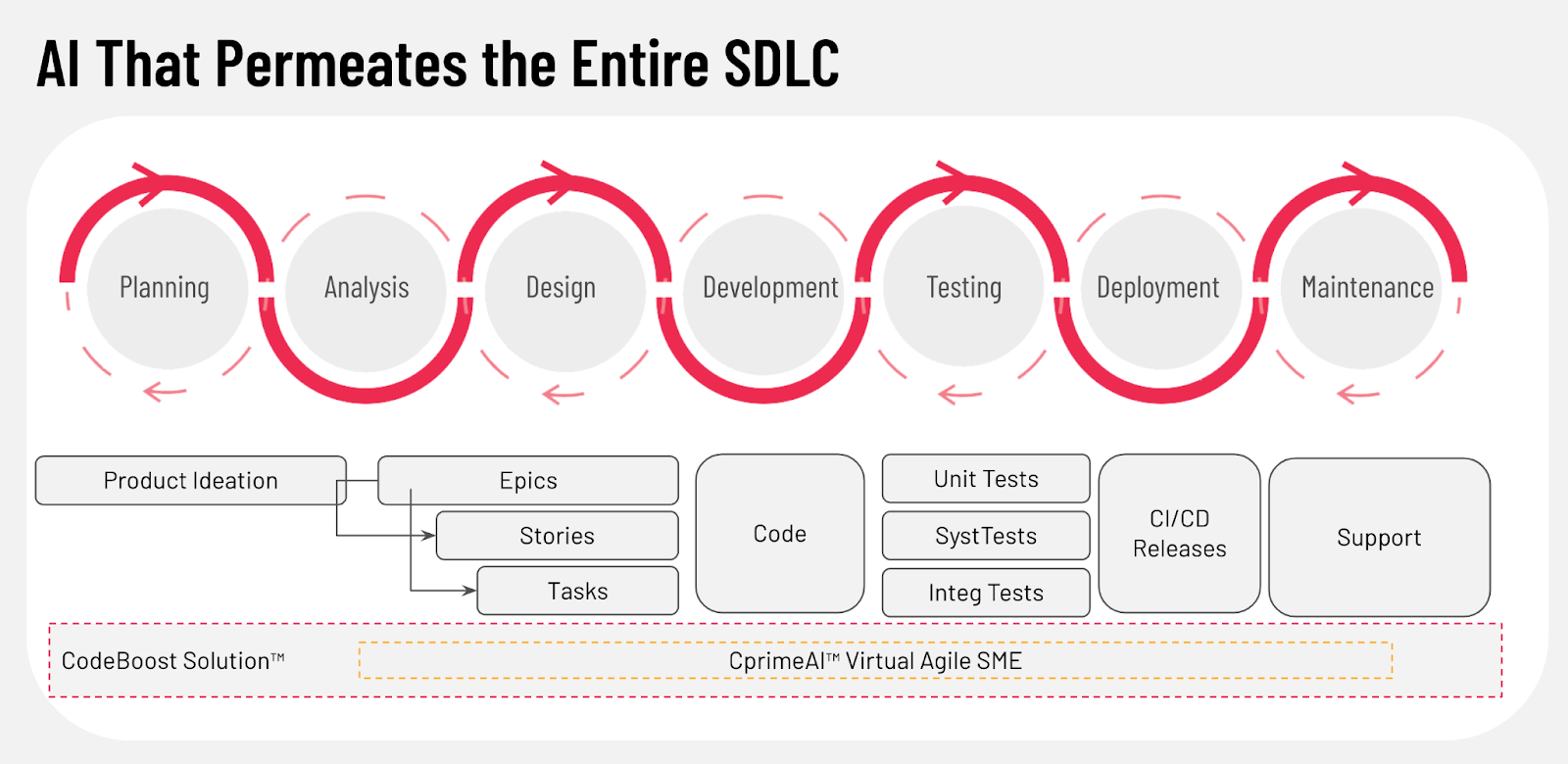Unlock Productivity and Innovation With Our ChatGPT Primer
In today’s fast-paced digital landscape, efficiency and innovation are more than goals; they’re necessities. Generative AI, particularly ChatGPT, can empower you in this quest. But it’s not quick and intuitive—you need actionable strategies and best practices to get the most out of this transformative technology.
As a first step down the road of leveraging generative AI for your business, let’s cover some basics.
What is generative AI?
Generative AI is a broad category of tools and applications designed to automate and innovate various aspects of business and personal tasks. It has a wide range of applications, from content creation to data analysis.
Knowing where to apply generative AI, whether in automating customer service or enhancing creative processes, is essential. Interestingly, the rise of generative AI can be likened to the “big data” buzz of 2011, indicating its transformative potential.
A brief ChatGPT primer
ChatGPT has emerged as a particularly accessible and popular form of generative AI. Its ease of use and real-world applicability make it a compelling choice for those looking to explore the world of AI.
OpenAI’s juggernaut has gained considerable attention for its ability to perform tasks ranging from drafting emails to generating code. Enterprises in every industry are scrambling to figure out how to put this powerful application—and ones like it—to use solving real world business problems.
Leveraging ChatGPT in the enterprise: not just a tool, an assistant
In an enterprise setting, ChatGPT can serve as a valuable assistant, aiding in tasks like content generation and data analysis. Its capabilities extend far beyond simple text generation; it can help kickstart projects, providing a foundation upon which to build.
For instance, if your marketing team is working on a new campaign, ChatGPT can generate initial drafts for email copy, social media posts, or even whitepapers. This not only speeds up the creative process but also allows your team to focus on fine-tuning the content.
Similarly, in the realm of data analysis, ChatGPT can sift through large datasets to identify key trends or anomalies, serving as a first pass before human analysts dive deeper into the data.
The “second-year intern” analogy
The model’s capabilities can be likened to that of a “second-year intern”—someone who has enough experience to handle a variety of tasks but still requires supervision. This has implications for job roles in the future.
As ChatGPT takes on more routine tasks, professionals can focus on strategic, creative, and more complex aspects of their work. For example, a data scientist could use ChatGPT to handle initial data cleaning and basic analysis, freeing them to focus on more complex modeling and interpretation.
Technical expertise required
To maximize the utility of ChatGPT, a team with some technical expertise may be required, especially for tasks like scripting or using APIs.
For example, integrating ChatGPT into your customer relationship management (CRM) system to automate certain customer interactions would likely require knowledge of APIs. Similarly, if you’re looking to use ChatGPT for more advanced data analysis tasks, some familiarity with scripting could be beneficial to customize the model’s queries and interpret its outputs effectively.
Caveats and limitations: know before you go
While generative AI and ChatGPT offer numerous advantages, it’s essential to be aware of their limitations. These limitations can impact everything from the quality of the output to data security, and being aware of them is crucial for responsible and effective use.
Error replication
One of the first things to note is that the model can replicate errors. For example, if you’re using ChatGPT to generate code snippets or automate parts of your software development process, it’s essential to double-check the output. An error in the code could lead to bugs that might be costly to fix later. Therefore, while ChatGPT can accelerate the development process, human oversight is still necessary to ensure accuracy.
The model is also notorious for replicating user errors. Users have reported being able to “trick” the AI with all manner of false information, with sometimes hilarious and sometimes nefarious results. In an effort to learn, ChatGPT has been known to absorb some very ugly ideas.
Outdated training data
Another limitation is the model’s training data, which cuts off in 2021. This makes it less reliable for tasks requiring real-time updates or current information.
For instance, if you’re in finance and looking to get the latest insights on emerging markets or investment trends, ChatGPT out-of-the-box might not be the best tool for the job. Its data is not up-to-date, and therefore, it can’t provide real-time market insights.
Some other generative AI applications offer limited access to current online content, but this can be problematic in its own way. ChatGPT experimented briefly with a real-time browser plugin in beta, but shut it down fairly quickly when it found that the AI was bypassing security protocols and absorbing tremendous amounts of false or inappropriate data from the internet. Eventually, those problems will be solved. But until then, ChatGPT’s knowledge of the world ends in 2021.
Data security concerns
Data security is a significant concern, especially for enterprises dealing with sensitive or confidential information. Some companies are cautious about using models like ChatGPT due to potential data security risks. For example, if you’re in healthcare and considering using ChatGPT for automating patient interactions, you’ll need to be extremely cautious due to the sensitive nature of medical data—using the public ChatGPT application means accepting that every bit of data passing through it can be stored and reviewed to train the model going forward.
To address data security concerns, solutions like private instances of these models are being developed. These private instances would reside within a company’s own infrastructure, providing an additional layer of security.
This is particularly useful for companies that need to adhere to strict compliance regulations, such as those in the financial or healthcare sectors. But really, every organization that wants to fully leverage generative AI would be well served to consider establishing a private instance to ensure proprietary and protected data remains safe.
Effective communication with ChatGPT: more than just commands
Interacting with ChatGPT or any other Language Learning Model (LLM) is not a dialogue to be taken lightly, especially in a corporate environment. The importance of iterative conversations and feedback loops is paramount for achieving precise and useful outcomes.
Clear and specific prompts
You might be looking to generate marketing copy for a new product launch. Instead of asking the model to “write some marketing content,” you could specify, “Please draft a compelling product description for our new line of ergonomic office chairs.”
The more detailed your prompt, the more aligned the output will be with your marketing objectives. You can mold the AI’s responses by requesting specific tone, telling it who your target audience is, and describing the way the finished content will be used.
Being specific is crucial when you’re dealing with business data analysis. For instance, if you’re looking to understand quarterly sales data, asking “Provide insights into Q2 2023 sales data for our software products” will yield a more focused and actionable analysis than a vague query like “Tell me about our sales.”
The deeper you drill down into details, the more insights ChatGPT can provide, as long as the broader context is available to work from.
Iterative process and feedback
ChatGPT learns from the feedback you provide, which is invaluable when you’re iterating on complex projects like a business proposal. If the initial draft isn’t aligned with the client’s needs, you can refine your prompt or provide additional context.
For example, if the first draft is too technical, you could say, “Revise the proposal to focus more on business outcomes and ROI.” Or, you could reference a particular sentence, paragraph, or section and say, “Expand on this statement by providing two examples of how it can be applied by HR professionals.”
Chain prompts for contextual outputs
Chain prompts allow you to build upon previous queries for more nuanced and contextual outputs.
For instance, after generating a list of potential leads, you could ask, “What would be an effective email subject line to engage these leads?” The model, remembering your previous query, can suggest a subject line that aligns with the type of leads you’re targeting.
Used in conjunction with iterative feedback, chain prompts can produce exceptional results with a little time and effort.
Identifying opportunities for generative AI: a framework for success
Understanding what machines excel at versus human capabilities is crucial when considering the implementation of generative AI. When evaluating tasks for automation, three key factors come into play: repeatability, scalability, and data orientation.
Repeatability
Tasks that are repetitive and follow a set pattern are prime candidates for automation. Generative AI excels in these areas because it can execute the same task consistently without fatigue or error, provided the task is well-defined.
For example, if you’re looking to automate the generation of monthly reports, generative AI can be programmed to pull the same types of data and format them in a consistent manner, saving valuable human hours.
Scalability
Another factor to consider is scalability. If a task needs to be performed on a larger scale, generative AI can easily handle the increased workload without requiring a proportional increase in resources.
For instance, customer service chatbots powered by generative AI can handle hundreds or even thousands of queries simultaneously, providing quick and consistent responses. This is something that would be incredibly resource-intensive if done by human agents.
Data Orientation
Generative AI shines in tasks that are data-oriented. These are tasks that require the analysis or interpretation of large sets of data.
For example, generative AI can sift through vast amounts of market research data to identify trends or patterns, tasks that would take a human analyst a significant amount of time. The AI can then generate summaries or even predictive models based on this data, aiding in decision-making processes.
The transformative potential
Generative AI and ChatGPT are not just technological novelties; they are tools that are already significantly impacting how we work and innovate. To truly grasp the transformative power of these technologies, we invite you to dig deeper by watching a comprehensive webinar that covers these topics and includes live demonstrations: How to Unlock Productivity and Innovation With Generative AI and ChatGPT.
By embracing these advancements, you’re not just staying ahead of the curve; you’re shaping it. Welcome to the future.





